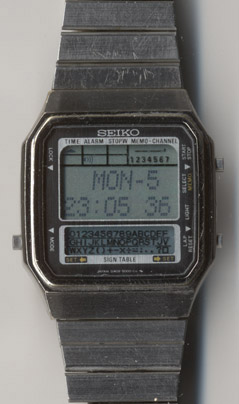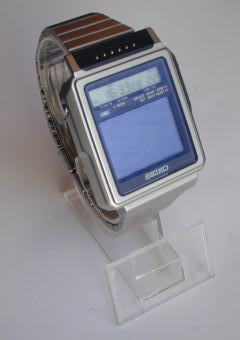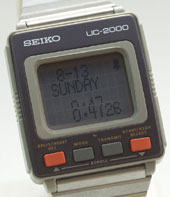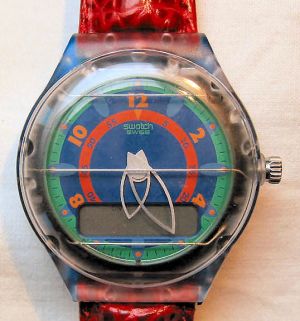Yesterday, I covered the history of the smart watch from the 1940s slide rule watch, to the 1970s calculator watch, and dipped into the 1980s with musical and gaming watches.
However, while some of those watches had processing ability, it was very limited, not programmable, and transient – once you were done processing data, you got back to the clock functionality, and whatever you were doing was gone. But, with Japanese electronics makers competing, some real innovation started.
So, we’ll pick up where we left off, in the early 1980s.
I’ll again refer to PocketCalculatorShow.com’s Nerd Watch Museum for much of this – it’s an excellent resource for this.
 In 1982, Seiko brought out their D409 memory watch, one of the first. It only had 112 bytes of memory, with arbitrary data in the “memos” stored in the watch.
In 1982, Seiko brought out their D409 memory watch, one of the first. It only had 112 bytes of memory, with arbitrary data in the “memos” stored in the watch.
This ultimately became a common theme among so-called databank watches, and to this day, Casio produces databank watches that follow a similar concept. (The modern ones do have keypads for entering data. No, that isn’t a touchscreen on the Seiko to the right.)
However, databank watches just have storage, but no real processing – they just display info, and in some cases, can’t even sync it. Therefore, for the most part, databank watches aren’t that historically interesting, although I’ll cover a few of the most interesting.
Before I do so, however, I need to cover what might be the coolest smart watch ever produced, though. It may not have much processing ability, but it does multimedia, and James Bond wore one.
 That watch is Seiko’s TV Watch, also from 1982. Unfortunately, the display had poor contrast, and you had to have an accessory to actually receive TV signals, but who cares, it’s an actual TV screen on an actual watch?
That watch is Seiko’s TV Watch, also from 1982. Unfortunately, the display had poor contrast, and you had to have an accessory to actually receive TV signals, but who cares, it’s an actual TV screen on an actual watch?
Due to LCD technology’s state, it would be quite a long time before the TV watch (or any multimedia watches beyond AM/FM radios) would be investigated again, though.
So, what did watch designers do in the mean time?
The easiest things to do were expand databanks, improve the abilities of calculator watches (Casio ended up coming out with scientific calculator watches, sadly unavailable today), and make combination databank and calculator watches, finally merging processing and storage.
However, we still don’t have programmability, and there’s no communications directed at the watch.
 In 1984, the first problem was solved – at least partially – by Seiko. (This post is looking like a Seiko ad, but I swear, I’m not trying to do that.)
In 1984, the first problem was solved – at least partially – by Seiko. (This post is looking like a Seiko ad, but I swear, I’m not trying to do that.)
Seiko brought out the Data-2000 and UC-2000 – both the same electronics, but the Data-2000 was marketed as a high-end databank watch, and the UC-2000 was marketed as a wrist computer.
Both watches were intended to work with a keyboard dock for entering data on the go, making data entry far easier than most databank watches. However, the UC-2000 was marketed alongside an even larger keyboard dock, that included a thermal printer, a Z80 processor, and a ROM cartridge slot.
This larger dock, the UC-2200, could actually run Microsoft BASIC (using the watch as a display), but it could also uplaod some small programs (written by Seiko, but it proved the ability of the watch to handle local processing of arbitrary code) to the watch’s RAM.
Also, computer connectivity began with Seiko’s lower-end RC-1000, and Apple II-specific UC-2001 (a variant of the UC-2000). This line would continue up until the early 1990s, with a few other models, including the Epson (a division of Seiko) RC-20 touchscreen watch.
 The next step, however, was the pager watch, supporting wireless communications directly aimed at the user’s watch.
The next step, however, was the pager watch, supporting wireless communications directly aimed at the user’s watch.
Seiko and Swatch came out with pager watches around the same time – Seiko’s Receptor in 1990, using a subcarrier on broadcast FM stations, and Swatch’s the Beep in 1991, using traditional paging protocols in Europe. Later, Timex would join the game in 1995 with their Beepwear.
There was one more interesting watch from this time period, though, that I’d like to cover – Timex’s Datalink. It used flashing patterns on a CRT display of a computer to download data. Not that interesting overall, except for the link method being rather novel.
Next time, we’ll head into the 2000s, and cover smart watches that can legitimately be called PDAs, as well as smarter variations on the pager watch.
Hello,
I am a Senior Apple Network Technician, in Tucson, Arizona, and I have recently Lost an expensive Timex Expedition Watch, but I Enjoy Reading Your Posts.
This Blog, might solve All My Problems. I have Also purchased [ In the Past], a NEW
SEIKO Databank Watch. Model Number is the UC-2001, and I cannot Find my old
Manual to restart the Watch. I am without Any /Time Pieces, NOW. Can Anyone PLEASE–> tell me how to reset the Watch, as It was working, and I remember that it takes a Special Key / to reset the Time and Date. I do NOT have the Magnetic Dock anymore, So, I am Stuck with another Dead Watch.
SEIKO Was NO Help, their downloads Page was a dead end for the UC-2001.
Can Someone Please Point me in the Right Direction, to fix this Watch? O’K?
You May call me with any Ideas, or tell me Where the Manual Is. My Phone Number is New, and Unlisted, but it is —> Ken /Grimes-Tucson, AZ, Area code is–> 520-210-7041. Thanks Everyone for any In-Site you might Give me,
Sincerely,
Ken J Grimes
Or e-mail me at ken_grimes123@yahoo.com–Thanks once more…